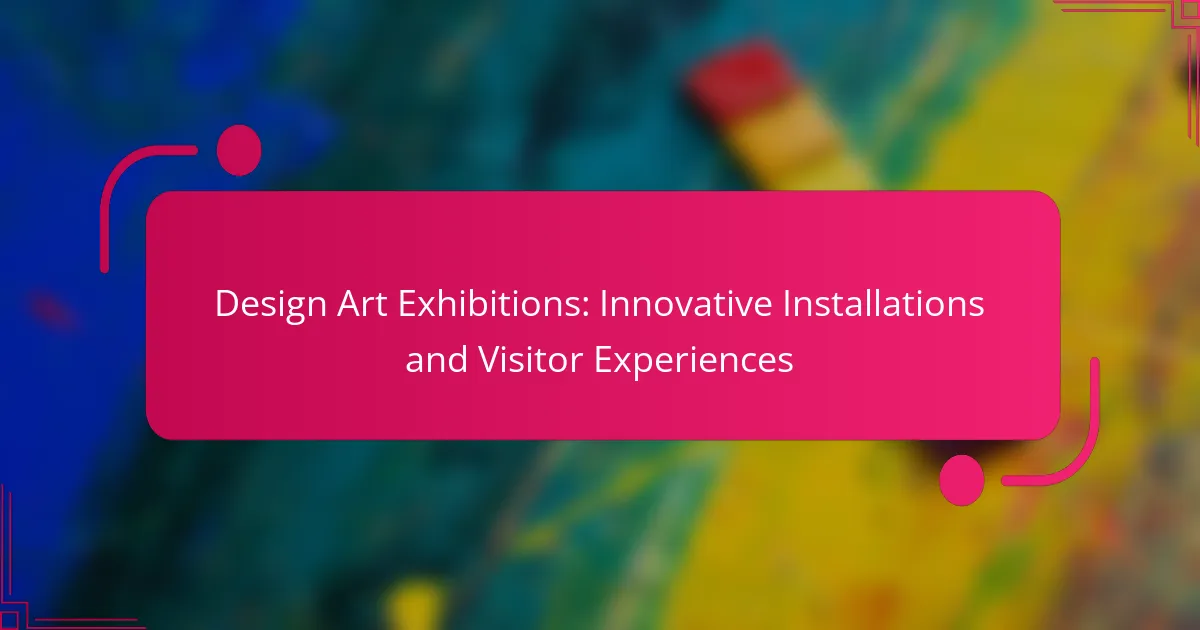Innovative design in art exhibitions enhances visitor experiences through interactive installations, immersive environments, and technology integration. Key elements include storytelling, sustainability, and cultural influences that shape exhibition layouts. Curators face challenges in balancing artistic vision with practical considerations while adapting to evolving visitor expectations. Emerging trends for 2025 focus on augmented reality and data analytics to optimize engagement and satisfaction.

What are the key elements of innovative design in art exhibitions?
Key elements of innovative design in art exhibitions include interactive installations, immersive environments, and thoughtful visitor engagement. These elements enhance the overall experience and foster deeper connections with the artwork.
Innovative design often employs technology, such as augmented reality or projection mapping, to create dynamic displays. Additionally, spatial design plays a crucial role, ensuring that the layout guides visitors through a curated journey.
Another important aspect is the integration of storytelling, allowing exhibitions to convey narratives that resonate with audiences. Finally, sustainability is increasingly a focus, with eco-friendly materials and practices being utilized in exhibition design.
How do interactive installations enhance visitor engagement?
Interactive installations significantly enhance visitor engagement by creating immersive experiences. These installations encourage active participation, making art more relatable. Visitors can interact with the artwork, fostering emotional connections and deeper understanding. Unique attributes such as sensory stimulation and real-time feedback differentiate these installations from traditional exhibits. As a result, visitors are more likely to remember and discuss their experiences, increasing overall satisfaction and repeat visits.
Which design principles are most effective in creating immersive experiences?
Effective design principles for immersive experiences include interactivity, sensory engagement, and storytelling. These principles enhance visitor connection and involvement.
Interactivity allows visitors to influence their experience, fostering personal engagement. Sensory engagement stimulates multiple senses, creating a memorable atmosphere. Storytelling provides context and emotional depth, guiding visitors through the exhibition.
Incorporating these principles can significantly enhance visitor experiences in design art exhibitions.
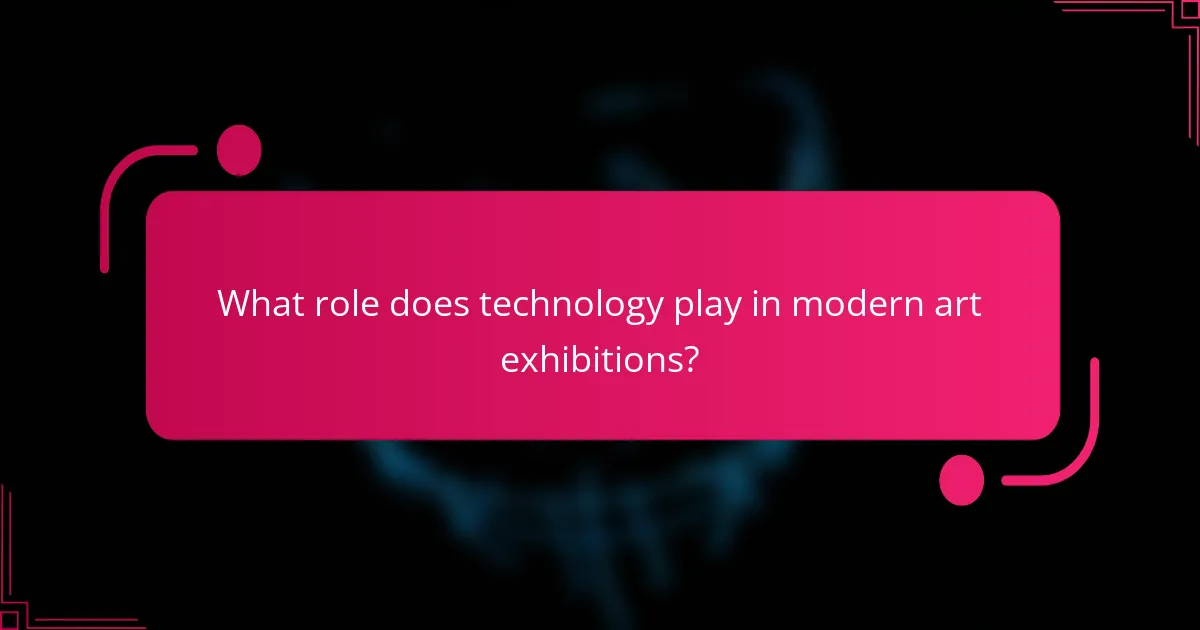
What role does technology play in modern art exhibitions?
Technology enhances modern art exhibitions by creating immersive experiences and interactive installations. Digital tools, such as augmented reality and virtual reality, allow visitors to engage with art in innovative ways. These technologies provide unique attributes, like personalized tours and interactive displays, which deepen visitor engagement. As a result, art exhibitions become dynamic spaces that foster creativity and connection. Additionally, data analytics help curators understand visitor preferences, tailoring experiences to enhance satisfaction. This integration of technology transforms traditional art viewing into a participatory journey.
How can augmented reality transform visitor experiences?
Augmented reality can significantly enhance visitor experiences by creating immersive and interactive installations. This technology allows for dynamic engagement with art, enabling visitors to visualize and interact with pieces in ways that traditional displays cannot. For example, AR can overlay digital information onto physical artworks, providing context and background that enrich the viewing experience.
Moreover, unique attributes of AR, such as real-time interaction and personalized content, allow visitors to tailor their experiences based on individual interests. This customization fosters deeper emotional connections with the art. As a result, augmented reality transforms passive observation into active participation, making exhibitions more memorable and impactful.
Incorporating AR into design art exhibitions can also attract a broader audience, including tech-savvy individuals and younger demographics. This innovation not only revitalizes traditional spaces but also encourages repeat visits, as each experience can be unique.
Overall, augmented reality stands as a powerful tool in the evolution of visitor experiences, reshaping how art is perceived and appreciated.
What are the benefits of incorporating digital art into physical spaces?
Incorporating digital art into physical spaces enhances visitor engagement and creates immersive experiences. Digital installations can transform environments, making them dynamic and interactive. This approach attracts diverse audiences and encourages participation, fostering a deeper connection to the art. Unique attributes of digital art, such as adaptability and real-time updates, allow for continuous evolution of exhibitions, keeping content fresh and relevant. As a result, visitors enjoy a memorable experience that blends technology with creativity.

How do cultural influences shape exhibition design across different regions?
Cultural influences significantly shape exhibition design by reflecting regional values and aesthetics. Different regions prioritize unique attributes, such as local art traditions, community engagement, and historical context. For instance, exhibitions in Japan often emphasize minimalism and harmony, while Western designs may focus on bold, interactive installations.
These variations enhance visitor experiences by aligning with cultural expectations. In regions with rich artistic heritage, exhibitions may incorporate traditional crafts, whereas contemporary urban areas might lean towards avant-garde approaches. As a result, the design of art exhibitions becomes a canvas for cultural expression, fostering deeper connections between art and audience.
Moreover, the integration of local narratives and social issues can create a more immersive experience. This approach not only showcases art but also invites reflection on cultural identity and societal values. Thus, understanding cultural influences is essential for creating innovative and meaningful exhibition designs.
What unique approaches are seen in European design art exhibitions?
European design art exhibitions often feature unique approaches that enhance visitor engagement and interaction. Notable trends include immersive installations that utilize technology, such as augmented reality, to create dynamic experiences. Another approach is the emphasis on sustainability, with many exhibitions showcasing eco-friendly materials and practices. Additionally, collaborative projects between artists and local communities are increasingly common, fostering a sense of connection and shared creativity. Finally, the integration of multidisciplinary elements, such as music and performance art, enriches the overall experience, making exhibitions more holistic and memorable.
How do North American trends differ in exhibition installations?
North American trends in exhibition installations emphasize interactivity and immersive experiences. These installations often incorporate technology to engage visitors more deeply.
Exhibitions in North America frequently feature large-scale, multimedia presentations that blend art with digital elements. This contrasts with European trends, which may focus more on traditional artistic expressions and static displays.
Visitor experience is enhanced through participatory elements, such as virtual reality and interactive displays. These innovations cater to a diverse audience, aiming to create memorable, shareable moments.
As a result, North American design art exhibitions prioritize engagement and innovation, appealing to contemporary cultural dynamics and technological advancements.
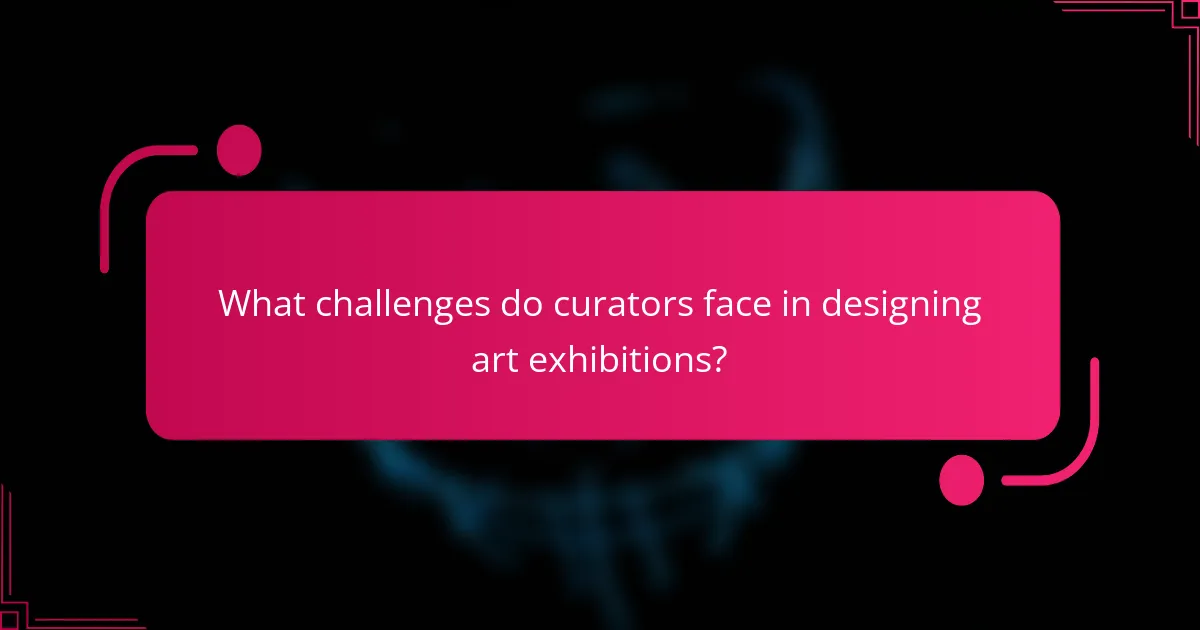
What challenges do curators face in designing art exhibitions?
Curators face challenges in designing art exhibitions, including limited budgets, space constraints, and audience engagement. They must balance artistic vision with practical considerations. Effective communication with artists and stakeholders is essential for successful installations. Additionally, curators need to adapt to evolving visitor expectations and technological advancements.
How can budget constraints impact the design process?
Budget constraints can significantly influence the design process of art exhibitions. Limited funding often leads to prioritizing essential elements, which can affect the overall creativity and innovation of installations.
Exhibition designers may need to simplify concepts or use cost-effective materials, potentially limiting unique attributes of the installations. For instance, they might rely on digital displays instead of elaborate physical setups. This can lead to a focus on visitor experiences that are interactive yet budget-friendly.
Moreover, budget constraints can result in fewer resources for marketing and outreach, impacting visitor engagement. Designers must find innovative ways to attract audiences, often leveraging social media or community partnerships to enhance visibility without additional costs.
Ultimately, while budget limitations can challenge the design process, they can also spark creativity, pushing designers to explore unconventional solutions that resonate with visitors.
What are common logistical issues in exhibition setup?
Common logistical issues in exhibition setup include inadequate space planning, poor transportation coordination, and insufficient staff training. These factors can lead to delays, safety hazards, and suboptimal visitor experiences. Effective communication and detailed planning can mitigate these challenges. Additionally, unexpected technical failures can disrupt installations, impacting the overall quality of the exhibition.
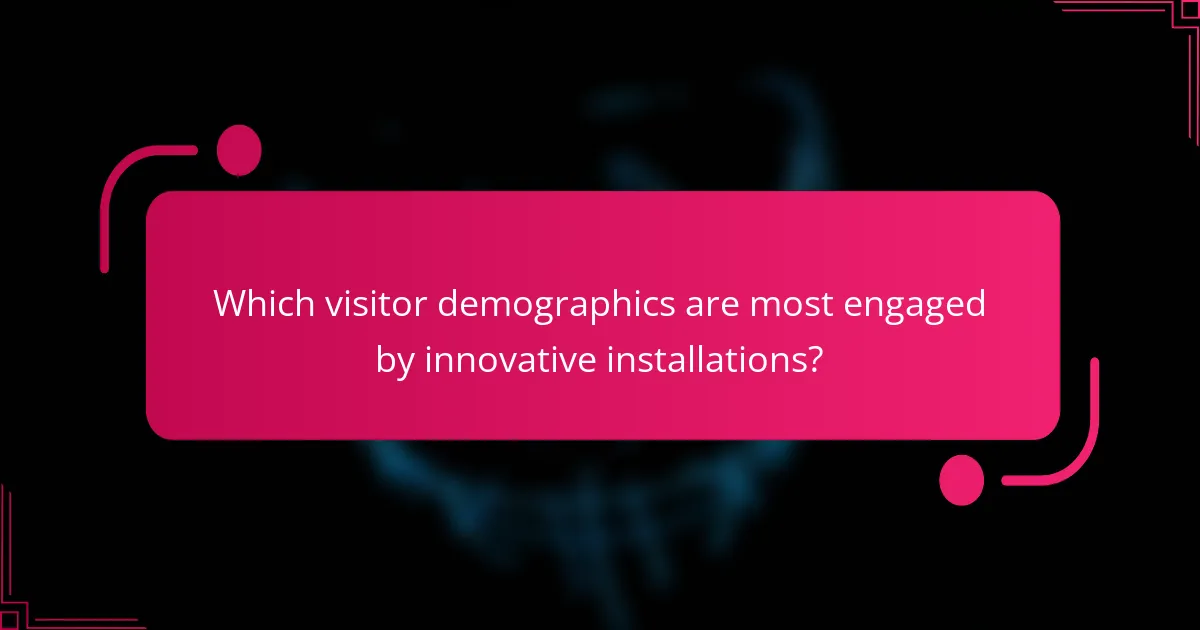
Which visitor demographics are most engaged by innovative installations?
Young adults and art enthusiasts are the most engaged demographics in innovative installations. These groups often seek immersive experiences that challenge traditional art boundaries. Additionally, families with children show interest, especially in interactive exhibits that promote learning. Surveys indicate that visitors aged 18-34 represent over 40% of attendance at such exhibitions. Engaging installations tend to attract diverse audiences, enhancing overall visitor experiences.
What strategies attract younger audiences to art exhibitions?
Interactive and immersive experiences attract younger audiences to art exhibitions. Incorporating technology, such as augmented reality and virtual reality, enhances engagement. Unique installations that invite participation foster a sense of community. Social media integration allows visitors to share their experiences, amplifying reach and appeal. Additionally, hosting events that blend art with music or food creates a vibrant atmosphere that resonates with younger demographics.
How do family-friendly features influence visitor turnout?
Family-friendly features significantly enhance visitor turnout at design art exhibitions. These features create an inclusive atmosphere, making exhibitions more accessible and enjoyable for families.
Interactive installations engage children and adults alike, fostering a shared experience. Additionally, amenities like family restrooms and designated play areas cater to the needs of parents, encouraging longer visits.
Exhibitions that incorporate educational programming attract families by providing enriching experiences. For example, workshops designed for various age groups allow family members to participate together, enhancing their connection to the art.
As a result, art exhibitions that prioritize family-friendly features often see increased attendance and positive feedback from visitors.
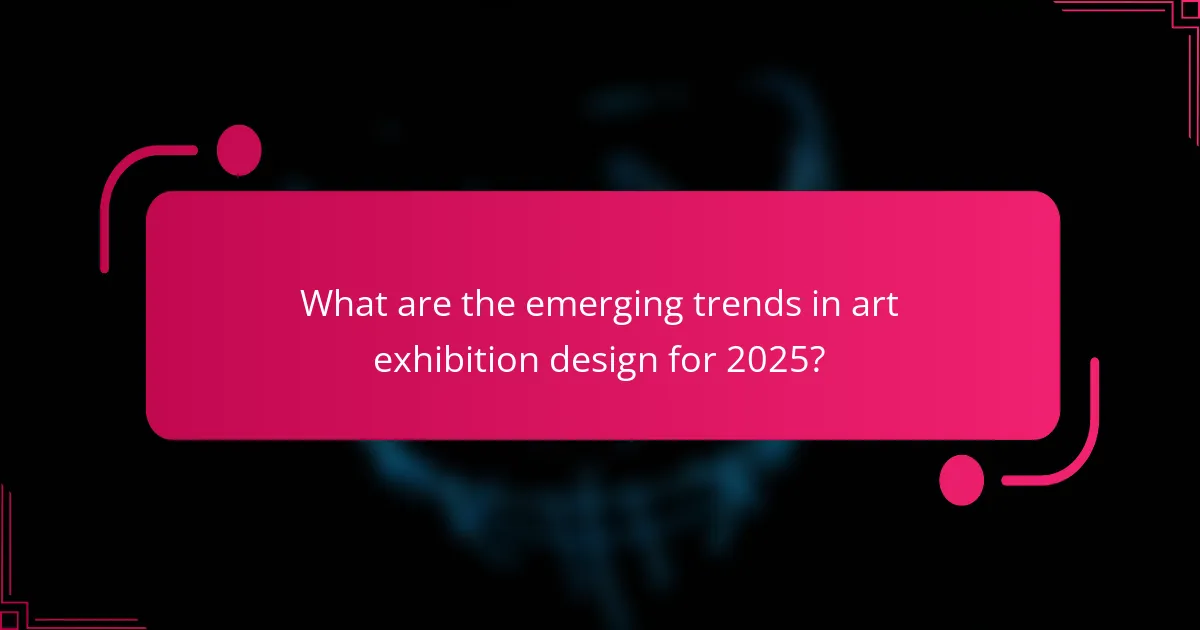
What are the emerging trends in art exhibition design for 2025?
Emerging trends in art exhibition design for 2025 focus on immersive experiences, sustainability, and technology integration. Exhibitions will increasingly utilize augmented reality to enhance visitor engagement. Sustainable materials will be prioritized, reflecting a growing commitment to environmental responsibility. Interactive installations will foster deeper connections between art and audiences. Additionally, data analytics will guide curatorial decisions, optimizing visitor flow and experience.
How are sustainability practices being integrated into exhibition planning?
Sustainability practices are increasingly integrated into exhibition planning through eco-friendly materials, energy-efficient lighting, and waste reduction strategies. Designers focus on creating installations that minimize environmental impact while enhancing visitor experiences. For example, using recyclable materials contributes to a circular economy. Additionally, incorporating digital technologies reduces the need for physical resources. Engaging visitors with sustainability themes fosters awareness and encourages responsible behavior.
What new forms of artistic expression are gaining popularity in installations?
Interactive installations, immersive experiences, and digital art forms are gaining popularity in design art exhibitions. These innovative approaches engage visitors in new ways, often blending physical and virtual elements. For example, augmented reality allows viewers to interact with artworks, enhancing their understanding and emotional connection. Additionally, sensory experiences using sound and light create atmospheric environments that captivate audiences. As a result, these trends redefine visitor experiences, making art more accessible and engaging.
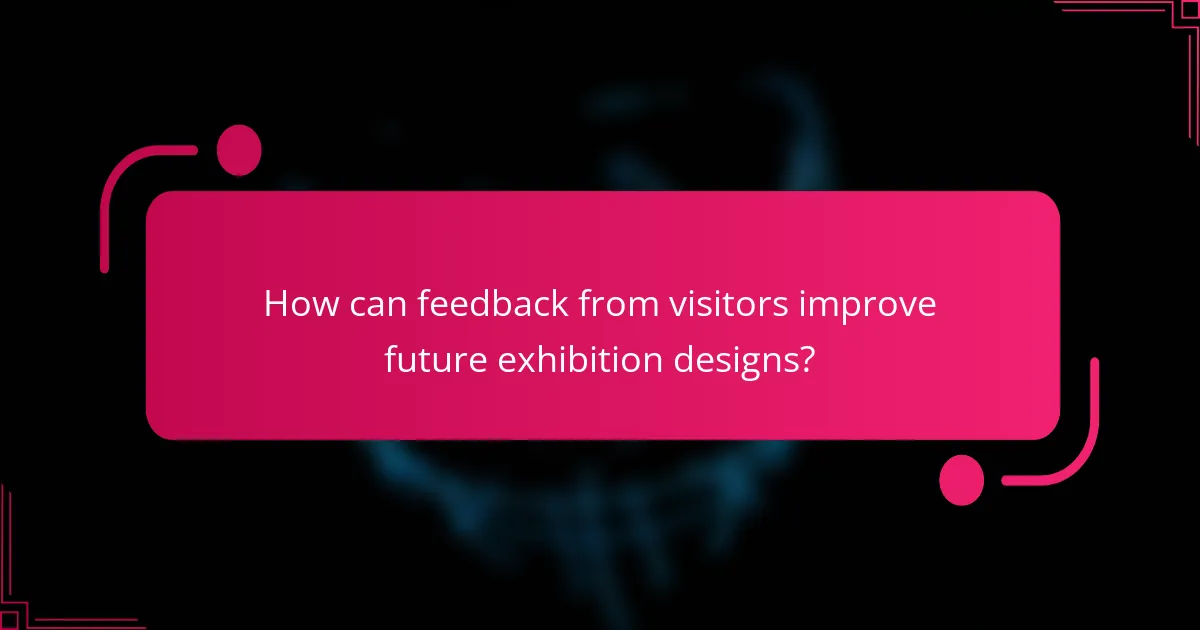
How can feedback from visitors improve future exhibition designs?
Feedback from visitors significantly enhances future exhibition designs by providing insights into their experiences and preferences. Analyzing visitor feedback allows designers to identify successful elements and areas needing improvement. This iterative process fosters innovation in installations and enhances engagement. For example, incorporating suggestions on layout or interactive features can create more immersive experiences. Ultimately, visitor feedback drives the evolution of art exhibitions, ensuring they remain relevant and impactful.
What methods are effective for collecting visitor insights?
Effective methods for collecting visitor insights include surveys, interviews, observation, and digital analytics. These approaches provide diverse data on visitor preferences and behaviors.
Surveys can capture quantitative data on visitor satisfaction and engagement. Interviews offer qualitative insights into visitor experiences and expectations. Observation allows for real-time understanding of visitor interactions with installations. Digital analytics track online engagement and attendance patterns.
Combining these methods enhances the depth and accuracy of visitor insights, informing future exhibition designs and visitor experiences.
How can data analytics shape the future of exhibition planning?
Data analytics can significantly enhance exhibition planning by providing insights into visitor behavior and preferences. By analyzing data, planners can tailor installations to create engaging experiences that resonate with audiences.
For example, tracking visitor paths through an exhibition can reveal popular areas and underutilized spaces. This information allows for strategic placement of art installations to maximize engagement. Additionally, data can inform the selection of themes and artists based on audience interest, ensuring relevance and appeal.
Moreover, predictive analytics can forecast attendance and help in resource allocation, optimizing staffing and materials. This data-driven approach not only improves visitor satisfaction but also enhances the overall impact of exhibitions.
In conclusion, leveraging data analytics transforms exhibition planning into a more informed, responsive process that prioritizes visitor experience and engagement.
What best practices should curators follow to optimize visitor experiences?
Curators should prioritize visitor engagement and accessibility to optimize experiences. First, design interactive installations that encourage participation. Use clear signage to guide visitors through the exhibition. Incorporate multimedia elements to enhance storytelling. Lastly, gather visitor feedback to continuously improve future exhibitions.
